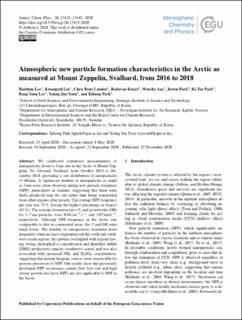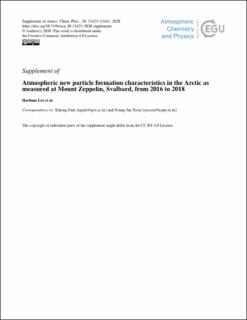| dc.contributor.author | Lee, Haebum | |
| dc.contributor.author | Lee, Kwangyul | |
| dc.contributor.author | Lunder, Chris Rene | |
| dc.contributor.author | Krejci, Radovan | |
| dc.contributor.author | Aas, Wenche | |
| dc.contributor.author | Park, Jiyeon | |
| dc.contributor.author | Park, Ki-Tae | |
| dc.contributor.author | Lee, Bang Yong | |
| dc.contributor.author | Yoon, Young Jun | |
| dc.contributor.author | Park, Kihong | |
| dc.date.accessioned | 2020-11-20T08:54:24Z | |
| dc.date.available | 2020-11-20T08:54:24Z | |
| dc.date.created | 2020-11-16T14:26:32Z | |
| dc.date.issued | 2020 | |
| dc.identifier.citation | Atmospheric Chemistry and Physics. 2020, 20, 13425-13441. | en_US |
| dc.identifier.issn | 1680-7316 | |
| dc.identifier.uri | https://hdl.handle.net/11250/2688815 | |
| dc.description.abstract | We conducted continuous measurements of nanoparticles down to 3 nm size in the Arctic at Mount Zeppelin, Ny Ålesund, Svalbard, from October 2016 to December 2018, providing a size distribution of nanoparticles (3–60 nm). A significant number of nanoparticles as small as 3 nm were often observed during new particle formation (NPF), particularly in summer, suggesting that these were likely produced near the site rather than being transported from other regions after growth. The average NPF frequency per year was 23 %, having the highest percentage in August (63 %). The average formation rate (J) and growth rate (GR) for 3–7 nm particles were 0.04 cm−3 s−1 and 2.07 nm h−1, respectively. Although NPF frequency in the Arctic was comparable to that in continental areas, the J and GR were much lower. The number of nanoparticles increased more frequently when air mass originated over the south and southwest ocean regions; this pattern overlapped with regions having strong chlorophyll a concentration and dimethyl sulfide (DMS) production capacity (southwest ocean) and was also associated with increased NH3 and H2SO4 concentration, suggesting that marine biogenic sources were responsible for gaseous precursors to NPF. Our results show that previously developed NPF occurrence criteria (low loss rate and high cluster growth rate favor NPF) are also applicable to NPF in the Arctic. | en_US |
| dc.language.iso | eng | en_US |
| dc.rights | Navngivelse 4.0 Internasjonal | * |
| dc.rights.uri | http://creativecommons.org/licenses/by/4.0/deed.no | * |
| dc.title | Atmospheric new particle formation characteristics in the Arctic as measured at Mount Zeppelin, Svalbard, from 2016 to 2018 | en_US |
| dc.type | Peer reviewed | en_US |
| dc.type | Journal article | en_US |
| dc.description.version | publishedVersion | en_US |
| dc.rights.holder | © Author(s) 2020. | en_US |
| dc.source.pagenumber | 13425-13441 | en_US |
| dc.source.volume | 20 | en_US |
| dc.source.journal | Atmospheric Chemistry and Physics | en_US |
| dc.identifier.doi | 10.5194/acp-20-13425-2020 | |
| dc.identifier.cristin | 1848394 | |
| dc.relation.project | NILU - Norsk institutt for luftforskning: 113007 | en_US |
| cristin.ispublished | true | |
| cristin.fulltext | original | |
| cristin.fulltext | original | |
| cristin.qualitycode | 2 | |


